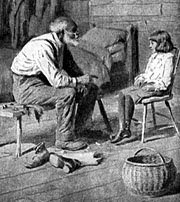 SEE HERE The economy has long since passed the critical point of the Laffer Curve where increasing taxes decrease revenue. (See world's largest Laffer Curve at left) There are lots of reasons for this. The fundamental problem is that the average person in the street things in short term linear terms about income that is simply money paid for work. This is a bad model for the economy as a whole. Work is more complex then a paycheck. Work is part of a complex economic reality of capital, rents, employment, organization, production, and consumption. Money works somewhat like oil in a machine. It makes it easier to exchange things. But it also conceals the underlying reality.
SEE HERE The economy has long since passed the critical point of the Laffer Curve where increasing taxes decrease revenue. (See world's largest Laffer Curve at left) There are lots of reasons for this. The fundamental problem is that the average person in the street things in short term linear terms about income that is simply money paid for work. This is a bad model for the economy as a whole. Work is more complex then a paycheck. Work is part of a complex economic reality of capital, rents, employment, organization, production, and consumption. Money works somewhat like oil in a machine. It makes it easier to exchange things. But it also conceals the underlying reality.The wealthy are not wealthy primarily because they have high incomes. Indeed, often enough they don't have particularly high incomes. It is the big corporations which often had highly remunerated chief executives that give the impression that there are many high incomes. That's partly because they are hired managers and not owner creators for the most part.
The reality is that the majority of the wealthy are wealthy because they have created organizations that employ people. They are the risk takers and the entrepreneurs. They generate the vast majority of the new jobs. If you make their life more uncertain they take precautions which contract the economy. Higher taxes hit your pocketbook in two ways if they are levied uniformly. They reduce your income directly and because of economic shrinkage they cause other things to become more scarce and more expensive so that reduces the availability of jobs and tends to drive the prices of things up. Particularly high rates on the rich simply cause the rich to quit working when their income approaches the tax threshold. This ripples down once more in shrinking economic effects, loss of jobs, loss of productive work. The result is that instead of the treasury getting more income, their income actually shrinks.
The opposite effect happens when the tax rates are lowered. The economy expands, prices tend to fall and employment expands and government revenue actually increases. Check it out: THE LAFFER CURVE This is also a worthwhile reference: SEE HERE This document concluded:
The Reagan tax cuts, like similar measures enacted in the 1920s and 1960s, showed that reducing excessive tax rates stimulates growth, reduces tax avoidance, and can increase the amount and share of tax payments generated by the rich. High top tax rates can induce counterproductive behavior and suppress revenues, factors that are usually missed or understated in government static revenue analysis. Furthermore, the key assumption of static revenue analysis that economic growth is not affected by tax changes is disproved by the experience of previous tax reduction programs. There is little reason to expect static revenue analysis to evaluate the economic or distributional effects of current tax reform proposals much better than it evaluated the Reagan tax program 15 years ago.










No comments:
Post a Comment